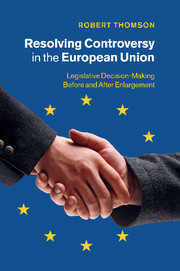 Resolving Controversy in the European Union
Resolving Controversy in the European Union Book contents
- Frontmatter
- Contents
- Figures
- Tables
- Acknowledgements
- 1 Introducing the political system of the European Union
- 2 Research design: measuring controversy spatially
- Part I Inputs
- Part II Processes
- Part III Outputs
- 12 Evaluating and improving the European Union
- Appendix The selection of legislative proposals
- References
- Index
2 - Research design: measuring controversy spatially
Published online by Cambridge University Press: 07 October 2011
- Frontmatter
- Contents
- Figures
- Tables
- Acknowledgements
- 1 Introducing the political system of the European Union
- 2 Research design: measuring controversy spatially
- Part I Inputs
- Part II Processes
- Part III Outputs
- 12 Evaluating and improving the European Union
- Appendix The selection of legislative proposals
- References
- Index
Summary
Applying the spatial model of politics to legislative decision-making in the European Union
The modern conception of politics is spatial. We think about political views that we agree with as close to our own, and views that differ from ours as further away. When we think of changes in the policy stances of political parties, it is common to think of parties moving to the left or to the right of the main ideological dimension that characterizes politics in our national contexts. Thinking about politics in terms of space has been with us for a long time. Thomas Carlyle’s account of the French National Constituent Assembly in July 1789, which was established after the French Revolution, describes a consistent ordering in the plethora of deputies’ views (Carlyle 1871: 192, cited in Benoit and Laver 2006: 16). He observed a consistency between the physical location of deputies to the right or left of the president and their positions on the major issues of the day, the Revolution and the status of the aristocracy in France. The use of the terms Right and Left to denote Conservative and Liberal forces, as well as the more general notion of political difference as distance, has pervaded popular and academic writing about politics throughout the world until today.
Political scientists have systematized this spatial conception of politics; I will refer to this systematic conception as the spatial model of politics. Hotelling (1929) was one of the first to formulate a spatial model that could be applied to politics. In passing, he noted that his model of shopkeepers’ decisions regarding product prices and shop location on a street could be applied to politics (54–5). In particular, he drew an analogy between the physical clustering of shops a short distance from each other on a street and the convergence of policy stances taken by the Democrats and Republicans of his home country, the United States, at that time. However, it was not until Downs’ An Economic Theory of Democracy (1957) and Black’s The Theory of Committees and Elections (1958) that the analytical power of the spatial model of politics became apparent. Today, the spatial model is at least implicit in most research that tries to explain aspects of real-world politics.
- Type
- Chapter
- Information
- Resolving Controversy in the European UnionLegislative Decision-Making before and after Enlargement, pp. 21 - 48Publisher: Cambridge University PressPrint publication year: 2011


